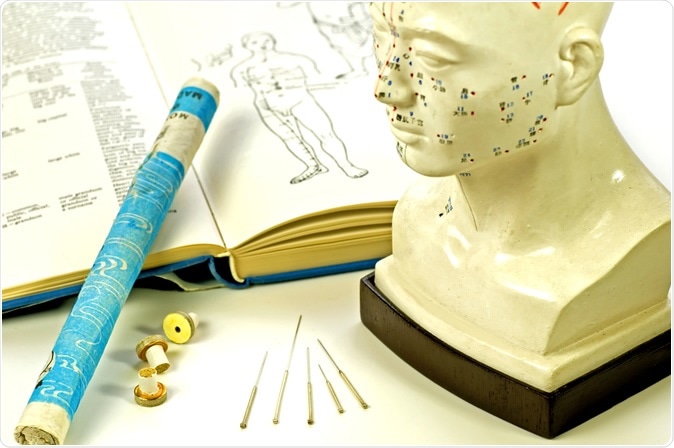Acupuncture is the subject of a new study from China published in The BMJ in March 2020, which reports that it is capable of reducing migraine headaches more effectively than either sham acupuncture or usual care.

Study assessed the efficacy of manual acupuncture as prophylactic treatment for acupuncture naive patients with episodic migraine without aura. Image Credit: Hjochen / Shutterstock
The condition
Migraine is a severe and unpredictable form of headache which affects over a billion people globally. It is a condition that severely impairs the quality of life as well as productivity and requires much support from society. It is estimated that migraine causes 45 million years of disabled life.
The prevention of migraines is an area of active research because many people have frequent attacks. However, despite the availability of many drugs, many patients fail to respond to the preventive agent. Many more do not want to be tied down to the use of a medication for the prevention of migraine.
Acupuncture has been recommended as a potential preventive modality for migraine, but the evidence can be construed both ways. There are two types of acupuncture, manual and electrical. This motivated the current study.
The study
The researchers included 147 patients known to have migraine without aura, who attended seven Chinese hospitals over the period from June 2016 to November 2018. Their average age was 37 years.
All the patients were assessed at baseline for one month, during which they were advised not to take painkillers or any other treatment modality. After four weeks, they were randomized to either 20 sessions of manual acupuncture at recognized acupuncture points with usual migraine care, 20 sessions of sham acupuncture at false points with usual care, or to receive advice about lifestyle and self-management as well as usual migraine care, for the next 8 weeks.
The first group followed a pattern of 10 sessions on alternate days, a 9-day break, and a second 10-session course.
The researchers then followed them up for 12 weeks, looking at how many days they had a migraine and the number of migraine attacks over each period of 4 weeks, starting from the baseline. Thus, they had six successive periods of observation, each lasting four weeks each.
The findings
About 82% of the study set were women
The investigators found that manual acupuncture produced a significantly higher decline in the number of days on which the patients had a migraine at weeks 13 to 20, compared to sham acupuncture – 2.2 days vs. 3.9 days. It was also linked to a smaller number of migraine attacks at the 17th to 20th weeks, at 1.6 attacks vs. 2.3 attacks. The trend appeared to be positive.
When adjusted for confounding factors, migraine days were 1.4 days fewer between week 13 and 16, and 2.1 days fewer at weeks 17 to 20. The corresponding figures with sham acupuncture vs. usual care were 1.6 vs. 0.4 attacks at weeks 17 to 20, and a somewhat declining trend over this period.
With all modalities, there were no severe side effects.
Implications
The researchers say some limitations were present such as the short 20-week period of study. However, the use of a non-penetrating sham acupuncture needle, and the blinded nature of the study, lent greater reliability to the results.
The findings show that manual acupuncture produced resulted in “a significantly higher reduction in the frequency of migraine days and migraine attacks.” As a result, say the researchers, it could be recommended as a preventive treatment. They say doctors should “provide patients with information about acupuncture as an option when discussing prophylactic treatment strategies.”
The current study is limited in its size, the change in effect is modest, and the long-term benefits of acupuncture are unknown due to the very short period of the study. It would appear that it is premature to speak of acupuncture as “an effective treatment for episodic migraine,” as the linked editorial written by neurologist Heather Angus-Leppan claims.
Even while admitting the small effect observed with manual acupuncture, and the resulting difficulty in observing clinical benefit, she insists that it is a useful addition to the current repertoire of migraine therapeutics. Her main point is that effective prevention is happening in only about 10% of patients with frequent migraines.
In the face of a small and limited study, such recommendations seem to underline the fact that the secret agenda of such research is to help change the perception of acupuncture as an unproven tool used by complementary medicine practitioners to one which is based on clinical evidence.
Journal references:
- Xu, S., Yu, L., Luo, X, Wang, M., et al. (2020). Manual acupuncture versus sham acupuncture and usual care for prophylaxis of episodic migraine without aura: multicentre, randomised clinical trial. BMJ 2020;368:m697/ . http://dx.doi.org/10.1136/bmj.m697
- Angus,-Leppan. (2020) Manual acupuncture for migraine. BMJ 2020;368:m1096 doi: 10.1136/bmj.m1096, https://www.bmj.com/node/1023000.full